Handheld Magnetic-Compliant Gamma-Ray Spectrometer for Environmental Monitoring and Scrap Metal Screening †
Abstract
:1. Introduction
2. Instrument Design
2.1. Design Specifications
2.2. Scintillator and SiPM
2.3. Electronics
2.4. Mechanics
2.5. Embedded Processing and Software
2.6. Calibration and Self-Diagnostics
3. Results
3.1. Laboratory Characterization
3.1.1. Energy Resolution
3.1.2. Count Rate
3.1.3. High Temperature Operation
3.2. Field Validation
3.2.1. Inertial Test
3.2.2. Scrap Metal Detection
3.2.3. Operation in the Magnetic Field
3.2.4. Drone Flight
4. Conclusions
Author Contributions
Funding
Institutional Review Board Statement
Informed Consent Statement
Data Availability Statement
Acknowledgments
Conflicts of Interest
References
- Gola, A.; Acerbi, F.; Capasso, M.; Marcante, M.; Mazzi, A.; Paternoster, G.; Piemonte, C.; Regazzoni, V.; Zorzi, N. NUV-Sensitive Silicon Photomultiplier Technologies Developed at Fondazione Bruno Kessler. Sensors 2019, 19, 308. [Google Scholar] [CrossRef] [PubMed] [Green Version]
- Yoo, W.; Shin, S.; Lee, D.; Jang, K.; Cho, S.; Lee, B. Development of a Small-Sized, Flexible, and Insertable Fiber-Optic Radiation Sensor for Gamma-Ray Spectroscopy. Sensors 2015, 15, 21265–21279. [Google Scholar] [CrossRef] [PubMed] [Green Version]
- Jiang, W.; Chalich, Y.; Deen, M.J. Sensors for Positron Emission Tomography Applications. Sensors 2019, 19, 5019. [Google Scholar] [CrossRef] [PubMed] [Green Version]
- Carminati, M.; Montagnani, G.L.; Occhipinti, M.; Kuehne, A.; Niendorf, T.; Nagy, K.; Nagy, A.; Czeller, M.; Fiorini, C. SPECT/MRI INSERT Compatibility: Assessment, Solutions, and Design Guidelines. IEEE Trans. Radiat. Plasma Med. Sci. 2018, 2, 369–379. [Google Scholar] [CrossRef]
- Peura, P.; Bélanger-Champagne, C.; Eerola, P.; Dendooven, P.; Huhtalo, E. Thin NaI(Tl) Crystals to Enhance the Detection Sensitivity for Molten 241Am Sources. Appl. Radiat. Isot. 2018, 139, 121–126. [Google Scholar] [CrossRef]
- Solovev, D.B.; Merkusheva, A.E. Use of Portal Monitors for Detection of Technogenic Radioactive Sources in Scrap Metal. IOP Conf. Ser. Mater. Sci. Eng. 2017, 262, 012198. [Google Scholar] [CrossRef]
- Kim, J.; Park, K.; Hwang, J.; Kim, H.; Kim, J.; Kim, H.; Jung, S.-H.; Kim, Y.; Cho, G. Efficient Design of a ∅2×2 Inch NaI(Tl) Scintillation Detector Coupled with a SiPM in an Aquatic Environment. Nucl. Eng. Technol. 2019, 51, 1091–1097. [Google Scholar] [CrossRef]
- Available online: https://Www-Ns.Iaea.Org/Downloads/Rw/Meetings/Tarragona2009/Presentations-Thursday/a-Cortes.Pdf (accessed on 15 January 2022).
- Available online: https://Www-Ns.Iaea.Org/Downloads/Rw/Meetings/Tarragona2009/Presentations-Thursday/b-Saha.Pdf (accessed on 15 January 2022).
- Masson, O.; Steinhauser, G.; Wershofen, H.; Mietelski, J.W.; Fischer, H.W.; Pourcelot, L.; Saunier, O.; Bieringer, J.; Steinkopff, T.; Hýža, M.; et al. Potential Source Apportionment and Meteorological Conditions Involved in Airborne 131 I Detections in January/February 2017 in Europe. Environ. Sci. Technol. 2018, 52, 8488–8500. [Google Scholar] [CrossRef] [Green Version]
- Moszyński, M.; Zalipska, J.; Balcerzyk, M.; Kapusta, M.; Mengesha, W.; Valentine, J.D. Intrinsic Energy Resolution of NaI(Tl). Nucl. Instrum. Methods Phys. Res. Sect. A Accel. Spectrometers Detect. Assoc. Equip. 2002, 484, 259–269. [Google Scholar] [CrossRef]
- Lowdon, M.; Martin, P.G.; Hubbard, M.W.J.; Taggart, M.P.; Connor, D.T.; Verbelen, Y.; Sellin, P.J.; Scott, T.B. Evaluation of Scintillator Detection Materials for Application within Airborne Environmental Radiation Monitoring. Sensors 2019, 19, 3828. [Google Scholar] [CrossRef] [Green Version]
- Hung, D.T.; Van Hiep, C.; Khang, P.D.; Hai, N.X.; Anh, N.N.; Dinh, D.A.; Hao, T.V.N.; Pham, V. Gamma spectrum stabilization for environmental radiation monitoring stations using Nai(Tl) detector. Radiat. Prot. Dosim. 2020, 189, 48–55. [Google Scholar] [CrossRef] [PubMed]
- Menge, P.R.; Yang, K.; McLaughlin, M.; Bacon, B. Efficient Positioning of Silicon Photomultipliers on Large Scintillation Crystals. In Proceedings of the 2016 IEEE Nuclear Science Symposium, Medical Imaging Conference and Room-Temperature Semiconductor Detector Workshop (NSS/MIC/RTSD), Strasbourg, France, 29 October–6 November 2016; pp. 1–5. [Google Scholar]
- Morozov, A.; Solovov, V.; Martins, R.; Neves, F.; Domingos, V.; Chepel, V. ANTS2 Package: Simulation and Experimental Data Processing for Anger Camera Type Detectors. J. Inst. 2016, 11, P04022. [Google Scholar] [CrossRef]
- Montagnani, G.L.; Carminati, M.; Lavelli, E.; Morandi, G.; Rizzacasa, P.; Fiorini, C. SiPM-Based Scrap Metal Radioactivity Detector Embeddable in Lifting Electromagnets. In Proceedings of the 2018 IEEE Nuclear Science Symposium and Medical Imaging Conference Proceedings (NSS/MIC), Sydney, Australia, 10–17 November 2018; pp. 1–3. [Google Scholar]
- Cozzi, G.; Busca, P.; Carminati, M.; Fiorini, C.; Montagnani, G.L.; Acerbi, F.; Gola, A.; Paternoster, G.; Piemonte, C.; Regazzoni, V.; et al. High-Resolution Gamma-Ray Spectroscopy with a SiPM-Based Detection Module for 1” and 2” LaBr3: Ce Readout. IEEE Trans. Nucl. Sci. 2018, 65, 645–655. [Google Scholar] [CrossRef]
- Guberman, D.; Paoletti, R.; Rugliancich, A.; Wunderlich, C.; Passeri, A. Large-Area SiPM Pixels (LASiPs): A Cost-Effective Solution towards Compact Large SPECT Cameras. Phys. Med. 2021, 82, 171–184. [Google Scholar] [CrossRef]
- Buonanno, L.; Di Vita, D.; Carminati, M.; Camera, F.; Fiorini, C. Miniaturized USB-Powered Multi-Channel Module for Gamma Spectroscopy and Imaging. Rev. Sci. Instrum. 2021, 92, 063306. [Google Scholar] [CrossRef]
- Buonanno, L.; Vita, D.D.; Carminati, M.; Fiorini, C. GAMMA: A 16-Channel Spectroscopic ASIC for SiPMs Readout With 84-DB Dynamic Range. IEEE Trans. Nucl. Sci. 2021, 68, 2559–2572. [Google Scholar] [CrossRef]
- Tardocchi, M.; Conroy, S.; Ericsson, G.; Frenje, J.; Källne, J.; Traneus, E. The Monitoring System of a High Performance Fusion Neutron Spectrometer. Nucl. Instrum. Methods Phys. Res. Sect. A Accel. Spectrometers Detect. Assoc. Equip. 2002, 485, 624–639. [Google Scholar] [CrossRef]
- Marturano, F.; Ciparisse, J.-F.; Chierici, A.; d’Errico, F.; Di Giovanni, D.; Fumian, F.; Rossi, R.; Martellucci, L.; Gaudio, P.; Malizia, A. Enhancing Radiation Detection by Drones through Numerical Fluid Dynamics Simulations. Sensors 2020, 20, 1770. [Google Scholar] [CrossRef] [Green Version]
- Ye, M.; Gong, P.; Wu, S.; Li, Y.; Zhou, C.; Zhu, X.; Tang, X. Lightweight SiPM-Based CeBr3 Gamma-Ray Spectrometer for Radiation-Monitoring Systems of Small Unmanned Aerial Vehicles. Appl. Radiat. Isot. 2021, 176, 109848. [Google Scholar] [CrossRef]
- Huang, T.; Fu, Q.; Lin, S.; Wang, B. NaI(Tl) Scintillator Read out with SiPM Array for Gamma Spectrometer. Nucl. Instrum. Methods Phys. Res. Sect. A Accel. Spectrometers Detect. Assoc. Equip. 2017, 851, 118–124. [Google Scholar] [CrossRef]
- Carminati, M.; Turolla, A.; Mezzera, L.; Di Mauro, M.; Tizzoni, M.; Pani, G.; Zanetto, F.; Foschi, J.; Antonelli, M. A Self-Powered Wireless Water Quality Sensing Network Enabling Smart Monitoring of Biological and Chemical Stability in Supply Systems. Sensors 2020, 20, 1125. [Google Scholar] [CrossRef] [PubMed] [Green Version]
- Huo, J.; Liu, M.; Neusypin, K.A.; Liu, H.; Guo, M.; Xiao, Y. Autonomous Search of Radioactive Sources through Mobile Robots. Sensors 2020, 20, 3461. [Google Scholar] [CrossRef] [PubMed]
- Keller, O.; Benoit, M.; Müller, A.; Schmeling, S. Smartphone and Tablet-Based Sensing of Environmental Radioactivity: Mobile Low-Cost Measurements for Monitoring, Citizen Science, and Educational Purposes. Sensors 2019, 19, 4264. [Google Scholar] [CrossRef] [PubMed] [Green Version]
- Jeon, B.; Kim, J.; Lee, E.; Moon, M.; Cho, G. Pseudo-Gamma Spectroscopy Based on Plastic Scintillation Detectors Using Multitask Learning. Sensors 2021, 21, 684. [Google Scholar] [CrossRef] [PubMed]
- Buonanno, L.; Di Vita, D.; Carminati, M.; Fiorini, C. A Directional Gamma-Ray Spectrometer with Microcontroller-Embedded Machine Learning. IEEE J. Emerg. Sel. Top. Circuits Syst. 2020, 10, 433–443. [Google Scholar] [CrossRef]
- Pensieri, S.; Patiris, D.; Alexakis, S.; Anagnostou, M.N.; Prospathopoulos, A.; Tsabaris, C.; Bozzano, R. Integration of Underwater Radioactivity and Acoustic Sensors into an Open Sea Near Real-Time Multi-Parametric Observation System. Sensors 2018, 18, 2737. [Google Scholar] [CrossRef] [Green Version]
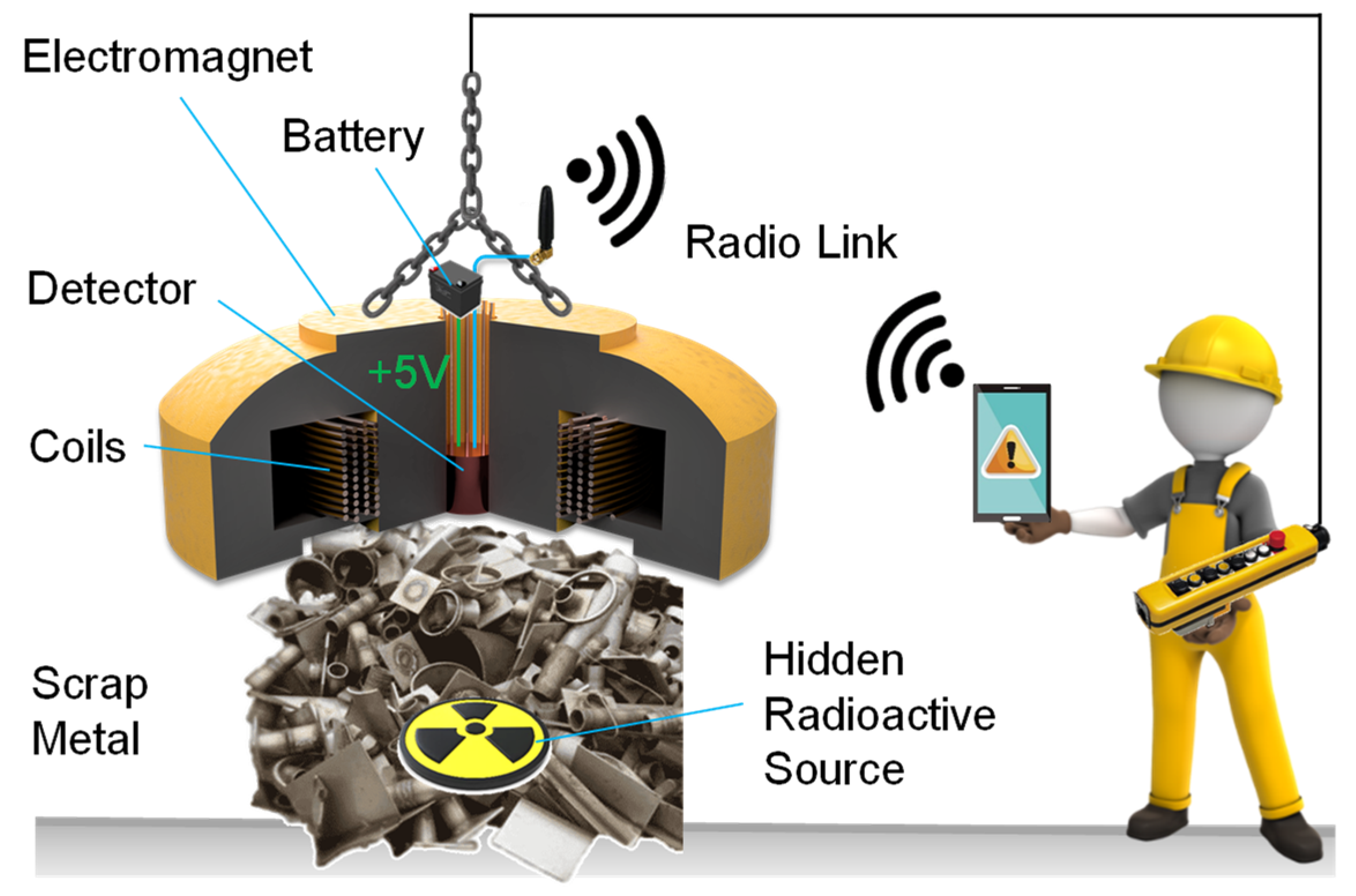
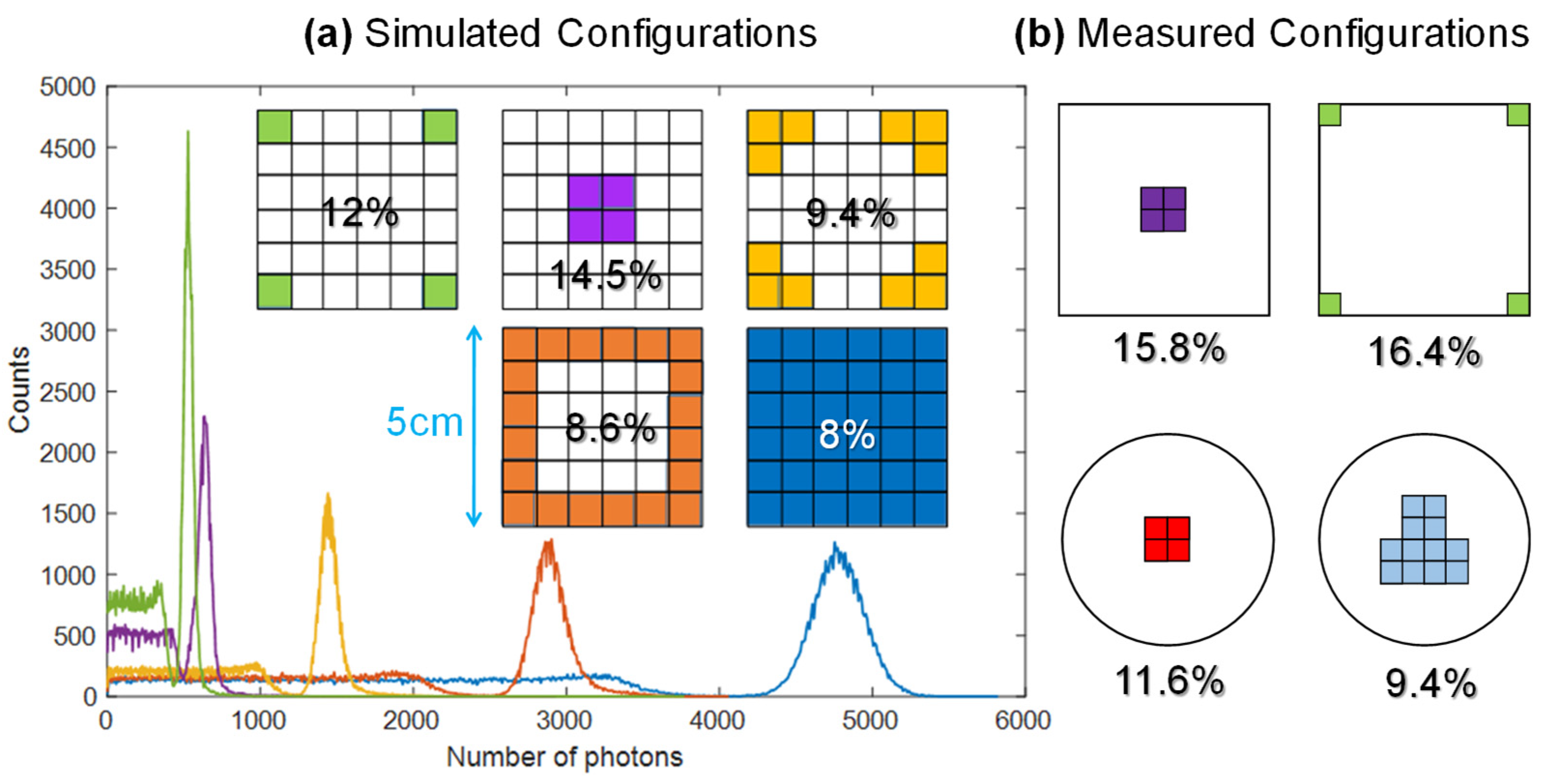
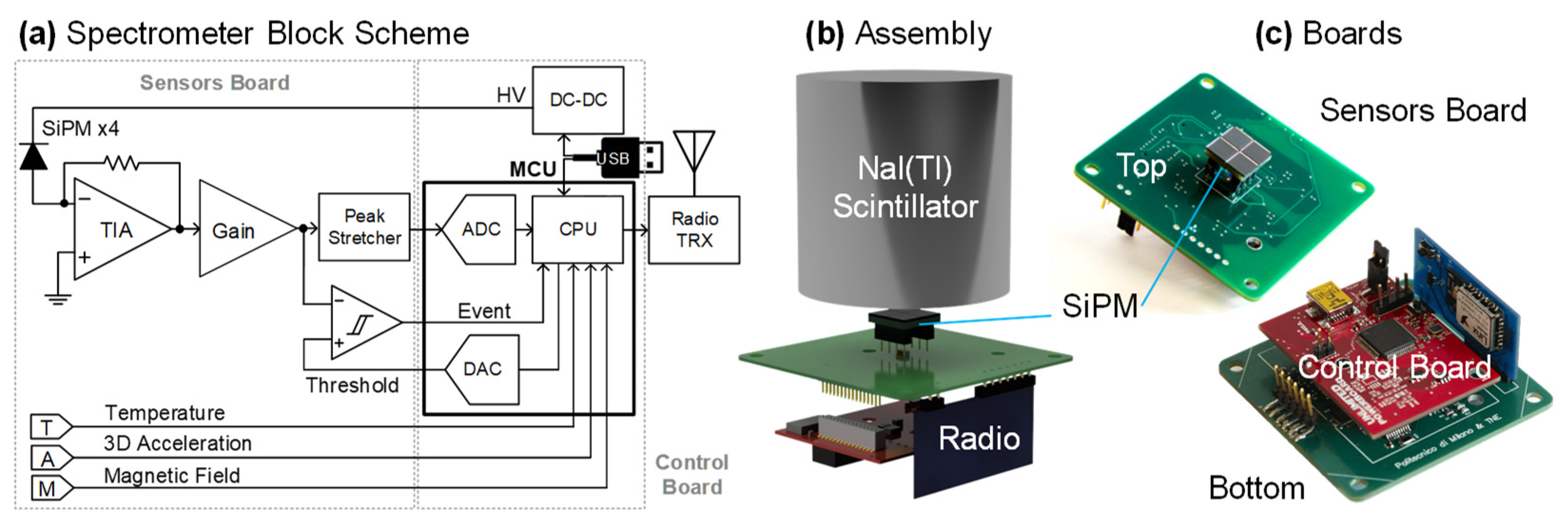



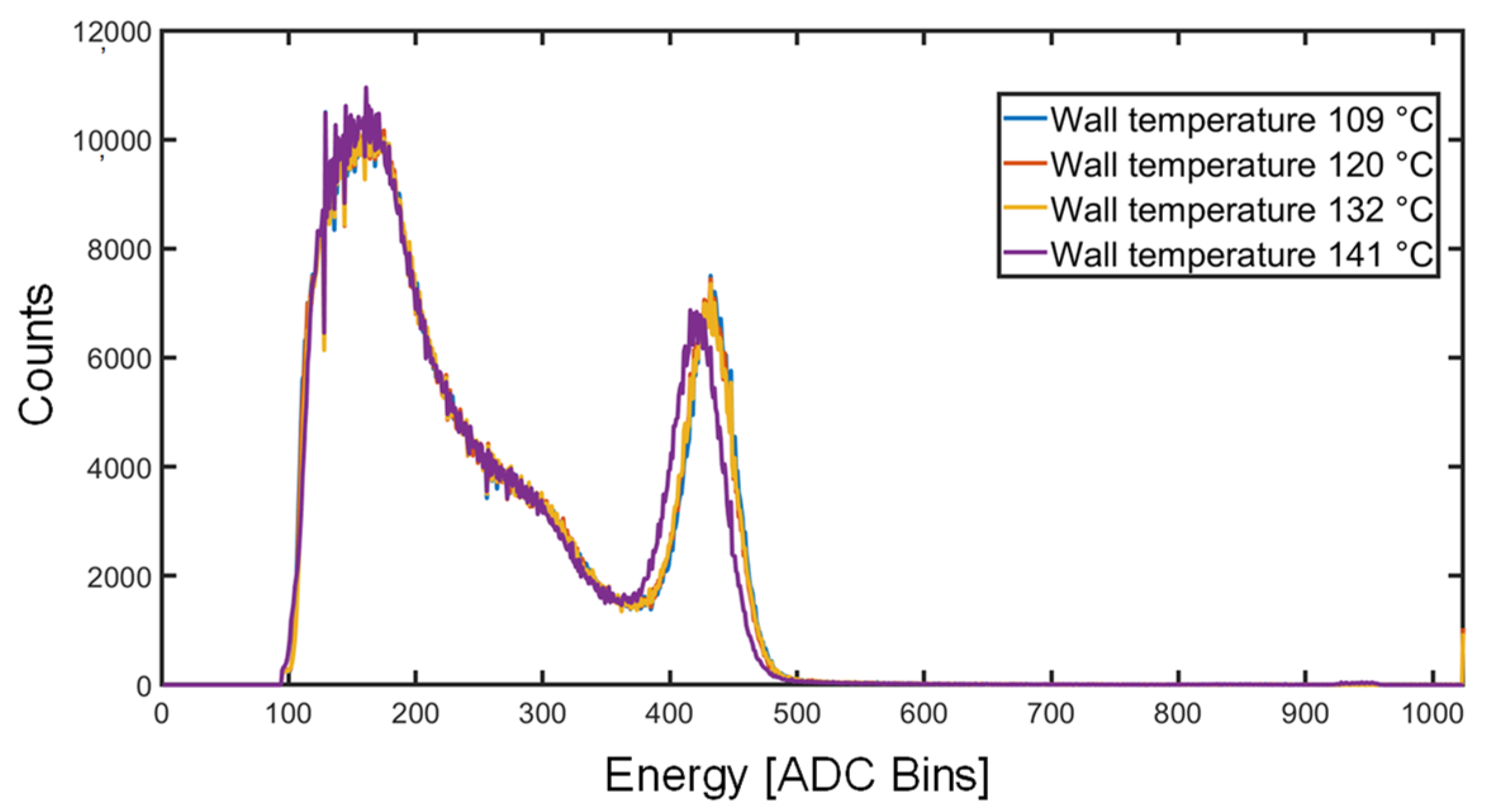
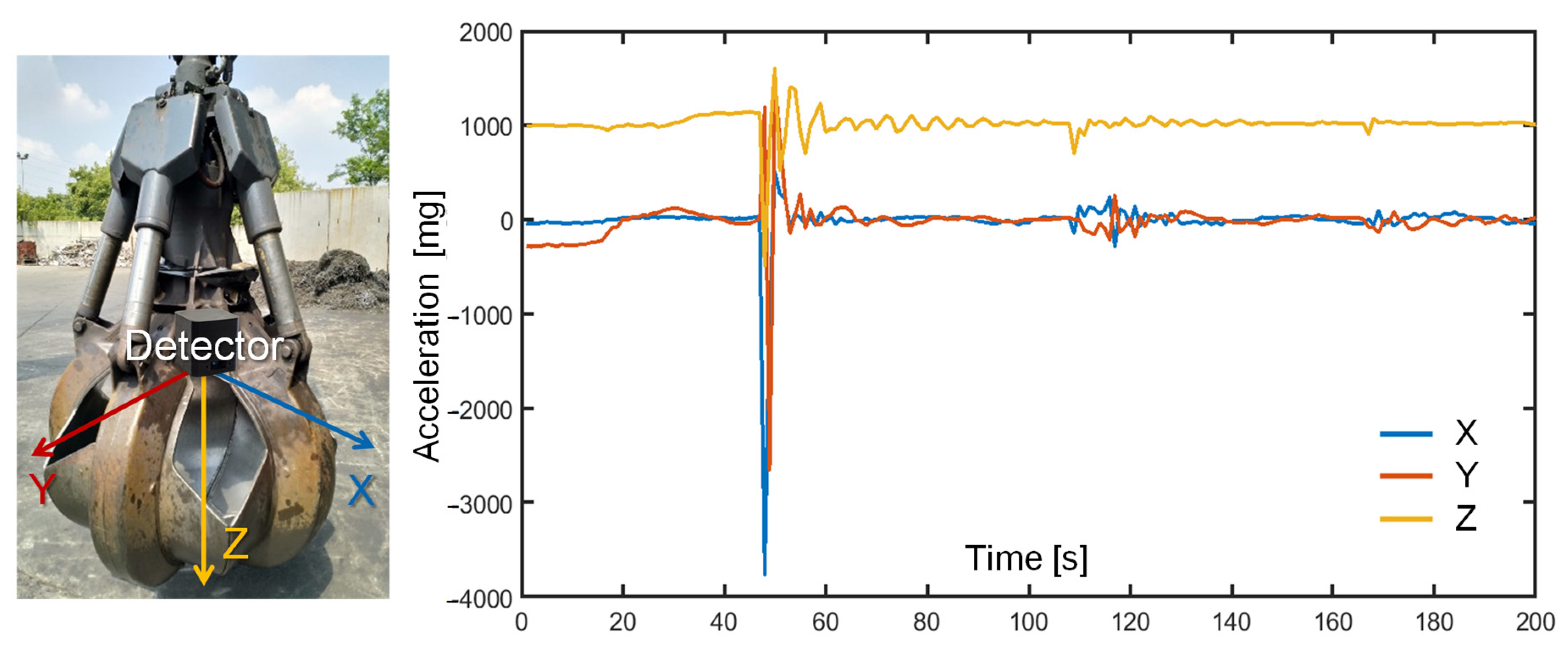
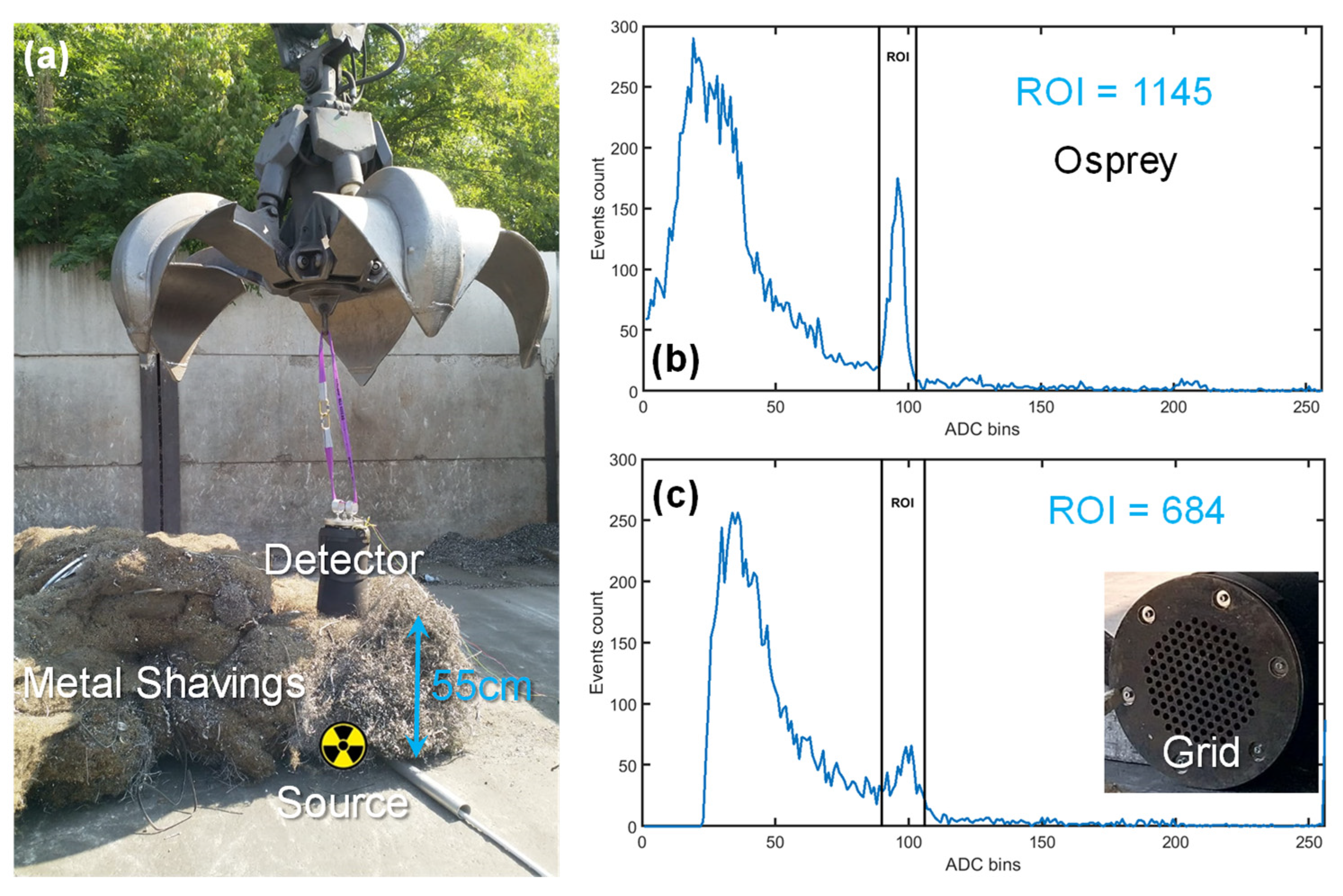
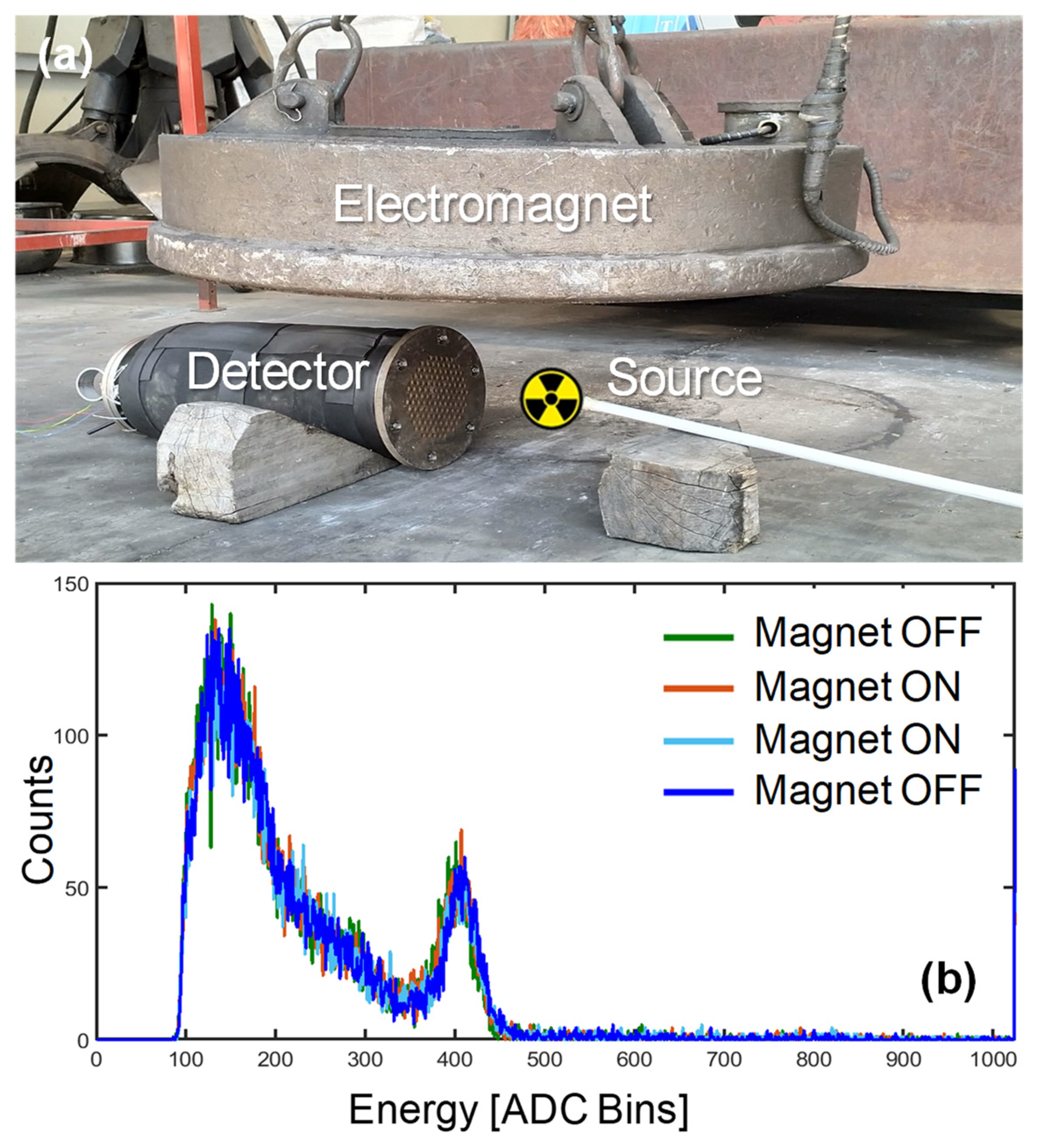
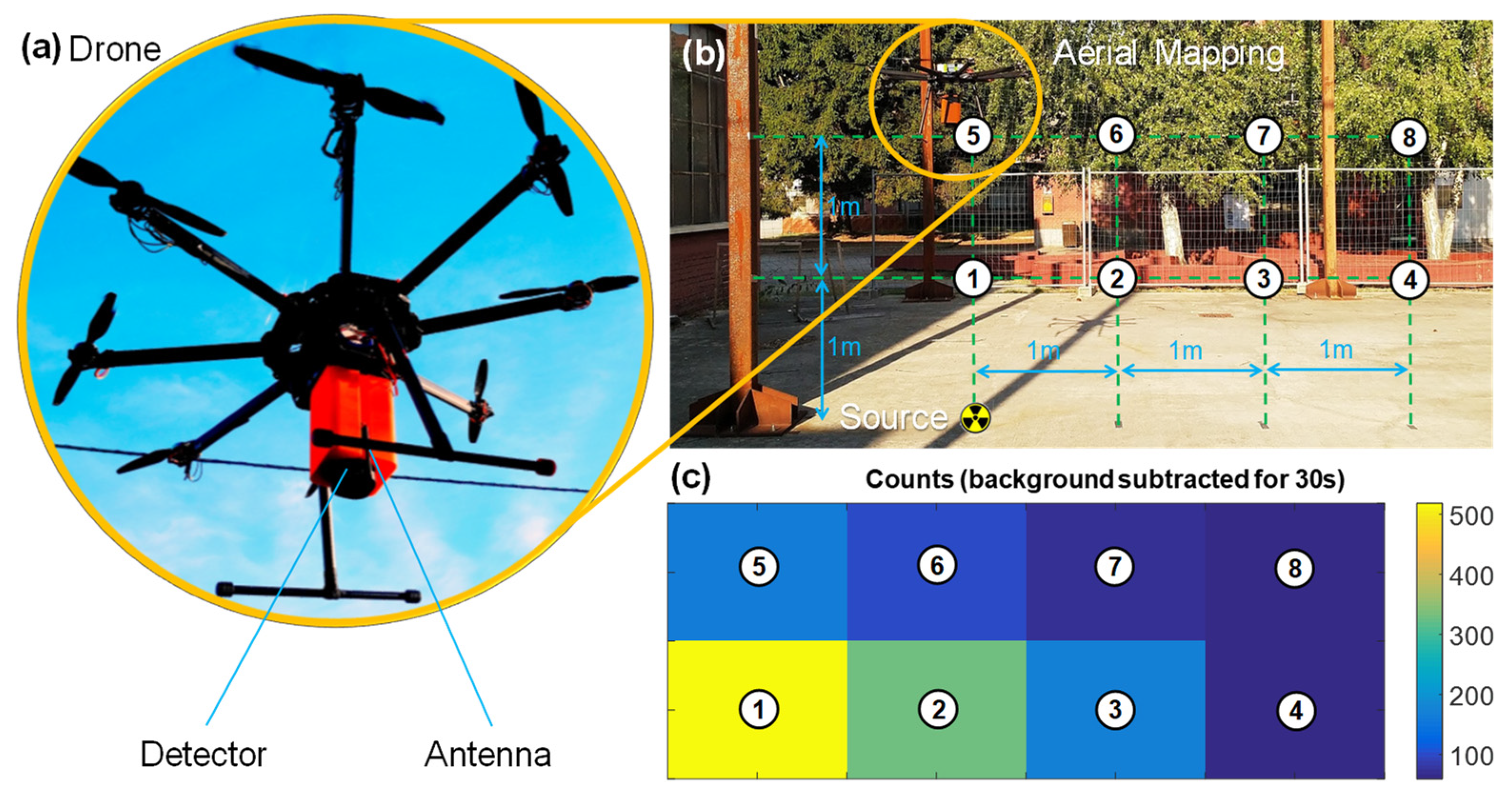
| Crystal Shape | # SiPM | Layout | Covered Area | Simulated | Measured |
|---|---|---|---|---|---|
| Cubic | 36 | Full coverage (blue) | 100% | 8% | - |
| Cubic | 20 | Ring (orange) | 55% | 8.6% | - |
| Cubic | 12 | Corners (yellow) | 33% | 9.4% | - |
| Cubic | 4 | Middle (purple) | 5.7% | 14.5% | 15.8% |
| Cubic | 4 | Corners (green) | 5.7% | 12% | 16.4% |
| Cylindrical | 4 | Middle (red) | 7.1% | 10.3% | 11.6% |
| Cylindrical | 12 | Middle (cyan) | 21.3% | 8.9% | 9.4% |
Publisher’s Note: MDPI stays neutral with regard to jurisdictional claims in published maps and institutional affiliations. |
© 2022 by the authors. Licensee MDPI, Basel, Switzerland. This article is an open access article distributed under the terms and conditions of the Creative Commons Attribution (CC BY) license (https://creativecommons.org/licenses/by/4.0/).
Share and Cite
Carminati, M.; Di Vita, D.; Morandi, G.; D’Adda, I.; Fiorini, C. Handheld Magnetic-Compliant Gamma-Ray Spectrometer for Environmental Monitoring and Scrap Metal Screening. Sensors 2022, 22, 1412. https://doi.org/10.3390/s22041412
Carminati M, Di Vita D, Morandi G, D’Adda I, Fiorini C. Handheld Magnetic-Compliant Gamma-Ray Spectrometer for Environmental Monitoring and Scrap Metal Screening. Sensors. 2022; 22(4):1412. https://doi.org/10.3390/s22041412
Chicago/Turabian StyleCarminati, Marco, Davide Di Vita, Giuseppe Morandi, Ilenia D’Adda, and Carlo Fiorini. 2022. "Handheld Magnetic-Compliant Gamma-Ray Spectrometer for Environmental Monitoring and Scrap Metal Screening" Sensors 22, no. 4: 1412. https://doi.org/10.3390/s22041412







